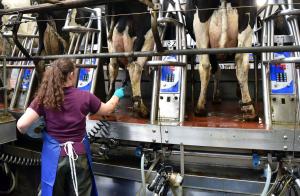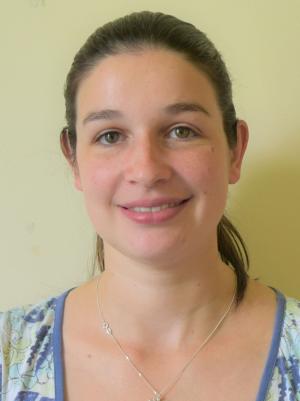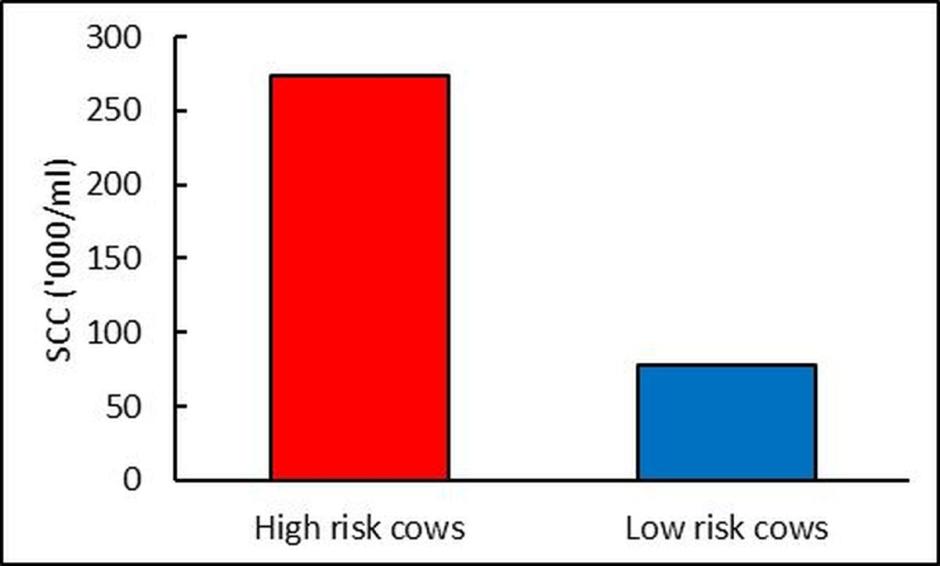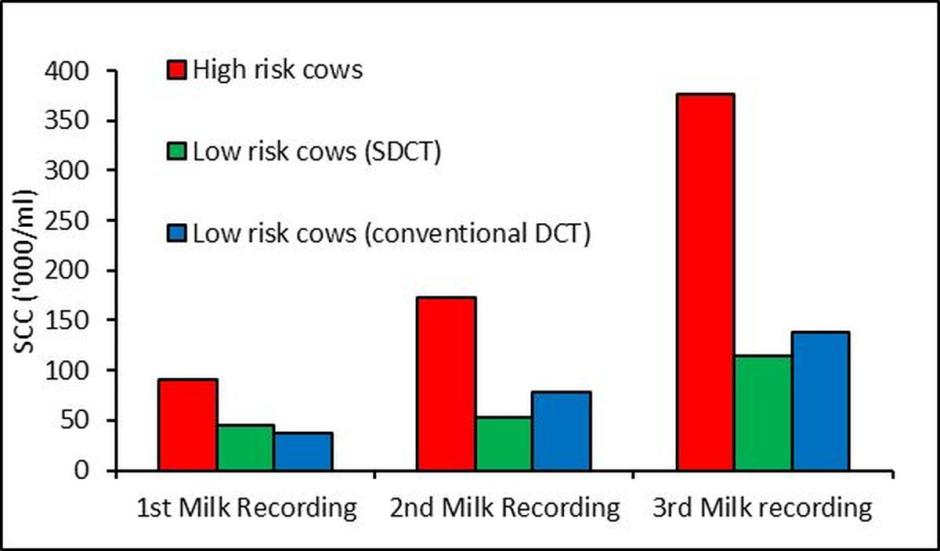Promising early results at AFBI on the use of selective dry cow therapy
Date published:
Background - As a result of the global threat from the emergence of antibiotic-resistant strains of bacteria, the livestock sector is facing mounting pressure to reduce antibiotic usage.

Given the importance of this issue, the Agri-Food and Biosciences Institute (AFBI), in partnership with AgriSearch, Animal Health and Welfare Northern Ireland, LMC and Farm Vet Systems, is leading a major research project entitled ‘STrategic AntiMicrobial use in Dairy, Beef and Lamb Production’ (STAMP). This project is co-funded through DAERA’s Research Challenge Fund. The objectives of this research programme include the development of user friendly systems to benchmarking antibiotic usage, and the development of decision support tools to help producers improve animal health.
Selective dry cow therapy (SDCT)

Within the dairy sector, one area where there appears to be considerable potential to reduce antibiotic usage is in relation to dry-cow therapy (DCT). ‘Blanket’ or conventional DCT, whereby all quarters of all cows are treated with an antibiotic at drying-off, has been normal practice on the majority of dairy farms for the last 30 – 40 years. The use of conventional DCT on all cows has been justified by the fact that dairy cows are particularly susceptible to mammary infection during the dry period, and that antibiotic dry-cow therapy provides an opportunity to prevent new infections from arising, as well as treating existing infections.
However, as a result of improvements in milking hygiene, together with the more widespread use of sires with the potential to reduce somatic cell counts and mastitis incidence in their offspring, bulk tank somatic cell counts (SCC) on many farms have fallen in recent years from 250,000 cells/ml in 2009 to 196,000 cells/ml in 2018 (DAERA statistics).
In view of this, and given the concerns about antibiotic resistance highlighted previously, farmers are being challenged to consider if it is really necessary to treat all cows in their herds with antibiotic dry-cow tubes at drying-off. Indeed, the use of ‘selective dry-cow therapy’ (SDCT) whereby only ‘high risk’ cows are treated with antibiotics at drying-off, may provide an ‘easy win’ strategy to reduce antibiotic use within the dairy sector. However, a common concern is that adoption of SDCT may increase the incidence of mastitis during the next lactation, meaning that any reduction in antibiotic use at drying-off will be off-set by the increased use of antibiotics during the subsequent lactation.
AFBI research
Given the interest in SDCT, a two year study is being undertaken to examine the impact of this practice within the AFBI Hillsborough dairy herd. The first year of this study (autumn 2018 - spring 2019) involved approximately 220 dairy cows. These cows were identified as either ‘high risk’ or ‘low risk’ based on their SCC and mastitis history. ‘High risk’ cows were those that had either one or more incidences of clinical mastitis during the three months pre dry-off, or a SCC of greater than 200,000 cells/ml during any of the three milk recordings prior to drying-off. These ‘high risk’ cows received conventional DCT, with all quarters treated with an antibiotic tube and a teat sealant at drying-off. Cows with no incidences of clinical mastitis during the three months before drying-off, and with a SCC of less than 200,000 cells/ml during the three milk recordings prior to drying-off, were considered ‘low risk’. ‘Low risk’ cows where allocated to one of two treatments. Cows on one treatment received conventional DCT (all quarters treated with an antibiotic tube and teat sealant at drying-off) while cows on the second treatment were treated with teat sealant only (SDCT).

The ‘high risk’ group had a mean lactation number of 3.0, compared to 2.1 for the ‘low risk’ group. This highlights that SCC and mastitis incidence generally increases with increasing lactation number. The ‘high risk’ cows had a mean SCC count of 273,000 cells/ml during the three milk recordings immediately prior to drying off, while ‘low risk’ cows had a mean SCC of 78,000 cells/ml during the three milk recordings prior to drying-off (Figure 1).

Neither milk yield or milk composition during the three months post-calving were affected by drying-off treatment (Table 1). During the three milk recordings post-calving, the mean SCC of the ‘high risk’ cows was 214,000 cells/ml. These ‘high risk’ cows had an average of 0.6 cases of mastitis per cow during that period. However, SCC of cows in the ‘Low risk’ groups remained low irrespective of whether they were subject to conventional DCT or SDCT (85,000 and 71,000 cells/ml, respectively; Figure 2). ‘Low risk’ cows that had been managed on SDCT had a similar incidence of mastitis during the three months post-calving as those managed on conventional DCT (0.2 cases of mastitis per cow).

The results of the first year of this study have demonstrated that SDCT was successfully adopted on ‘low risk’ cows within the AFBI herd without any negative effects on udder health or performance during the subsequent lactation. However, the success rate of SDCT is likely to be determined by a number of factors, including: 1) the overall SCC of the herd (the AFBI herd has a low SCC, and this is conducive to the adoption of SDCT), 2) the protocol used to differentiate between the ‘high risk’ cows which will require antibiotic treatment at dry-off and the ‘low risk’ cows for which SDCT is appropriate (participation in milk recording, together with good records of cows treated for mastitis is essential), and 3) hygiene at drying-off (excellent hygiene at drying off is essential to ensure that bacteria are not introduced into the udder at this time).
If you are considering adopting SDCT on your farm, speak with your vet who can provide you with more information, and help you develop an appropriate protocol for identifying ‘low risk’ cows.
Questionnaire of farmers who have adopted selective dry cow therapy
A number of local dairy farmers have already adopted SDCT on their farms. To complement the results of the current study, AFBI are planning to undertake a survey to gain a better insight into farmer’s experience of the adoption of SDCT. This questionnaire will seek to identify reasons for the adoption of SDCT, ‘best practice’ protocols being adopted on local farms, and the impact of SDCT on cow health and performance. Consequently, AFBI are seeking to recruit farmers from across Northern Ireland who have already adopted SDCT, and who are willing to participate in this short questionnaire. It will require no more than 30 minutes of your time. If you wish to find out more, or are willing to share your experiences of SDCT with us, please email aimee.craig@afbini.gov.uk or call 028 92681587.
Notes to editors:
AFBI carries out high quality technology research and development, statutory, analytical, and diagnostic testing functions for DAERA and other Government departments, public bodies and commercial companies.AFBI's Vision is “Advancing the Local and Global Agri-Food Sectors Through Scientific Excellence”.AFBI's core areas:- Leading improvements in the agri food industry;- Protecting animal, plant and human health;- Enhancing the natural and marine environment.All media enquiries to AFBI Press Office 028 9025 5326.